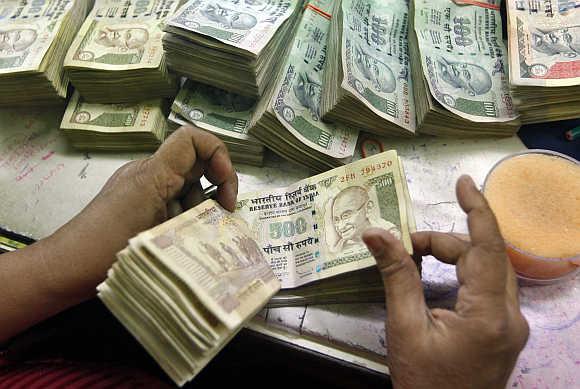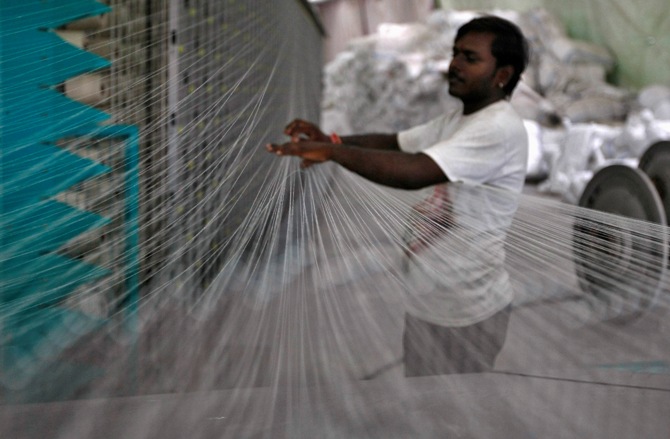
It will take more than three years to restart economic growth provided the new government, in all earnestness, brings in reforms right from the beginning, says M V Subramanian.
Continuing our series on the state of the Indian economy ahead of the general elections.
Read the first in the series here: From boom to doom, an uphill task to revive the economy
Most economic pundits and stock market experts predict a boom scenario for the Indian economy post the elections this year and a possible victory and assumption of office for the Bharatiya Janata Party.
But I would like to present a realistic picture of the economy in the next two years, going by my understanding and what I see of corporate earnings.
It will take more than three years to restart economic growth provided the new government, in all earnestness, brings in reforms right from the beginning.
Due to inflation not coming down, the Reserve Bank of India has been taking a tough stand and not budging to reduce or even give a hint of a reducing the interest rate regime.
The current governor Raghuram Rajan has not done anything different from the previous governor D Subbarao, except that he has managed to stabilise the rupee.
There is no unison between the RBI and the government on the steps to be taken to manage inflation and growth.
Targeting inflation management alone will not do good for the economy and also, banks were not transmitting the monetary measures as they have to see that their assets are growing at 18 per cent per annum.
…

The credit offtake is very low and only the retail assets have grown in all the banks for the past two years. The net margins of most of the banks are more or less in a stable manner for the past six quarters despite the increasing interest rate regime and liquidity issues.
The interest rates are so high in the market and the average rate for working capital finance for SME/MSME clients are around 13.5 per cent per annum.
Also, they depend on larger manufacturing units and big players and hence if their payments are delayed, the small units bear an additional burden.
The earnings of most corporates are down for the past 12 months and it is likely to remain so for the next 18 months.
This is without exception to any industry type. No new additional investments/expansions are happening across the industries and some of our credit analysts have forgotten how to analyse a term loan proposal.
They have neither seen any infrastructure proposal nor have they advised any corporate on acquisition.
One of the leading M&A bankers was telling me that they have plenty of "sell" deals but there are no buyers. Corporate debt restructuring cases are mounting and all them need equity to survive or repay debt obligations. Who is going to give them equity?
A few leading infra companies are even willing if bankers were to take over and run their companies as they see no cash flows from their companies and they just cannot raise money to repay the debt.
…

If most of the nationalised banks have started quoting that their NPAs are around 10 per cent of the asset book, you can imagine the kind of ''written-off'' cases to surface in the next 18 months. Who will provide capital to these banks? Where is the money going to come from? Both the primary and the secondary market for raising capital is so bad for the past one year, and the only success has been the tax-free bonds issued by PSUs.
For the past three years nothing was done by the government on the supply side. Palm oil was available so cheap last year in the international market which could have been imported to stabilise the edible oil prices at home.
Hoarding was happening for simple commodities like onions and potatoes, but not a single raid was carried to bring down the prices.
Petrol/diesel prices were decontrolled (the government announced it that way) but their price variations announced were government determined.
Milk prices have gone up during the past 24 months and this is the only industry which has got remunerative prices for the milk producers without a middleman and government intervention.
Rice, pulses and other commodities' prices shoot up but the real value doesn't reach the farmers.
…

Companies in sectors like automobiles, sugar, seeds, mines, infrastructure, power, telecom are all in trouble and it is unlikely these will come out of the difficult period in the next 12 months -- and none of them have any export earnings.
The market scenario for all the commodities is also not very encouraging. Two positive industries -- namely, Information Technology and pharma -- alone cannot lead the economy. At the same time, on the pharma side there are more and more negative news coming out about quality issues.
Agriculture income with a good monsoon is not going to boost our GDP as the value chain is not in favour of the farmers. Though rural income is growing as well as rural purchasing power by the consumption of FMCG goods and automobiles, the infrastructure and the irrigation facilities are not matching up.
Agricultural productivity has not substantially increased compared to many developing nations and we have not started using technology in a big way to boost agricultural production.
GM seeds for cotton alone had caught up across India giving better yield per acre, but the government has not brought out measures to assist farmers to get a better price realisation and market linked products.
Agriculture’s contribution to the overall GDP is around 18 per cent which has declined over the years from a level of 40 per cent in 1960s. In the case of emerging markets like India, the long term investment view of Foreign Institutional Investors has not changed and is positive.
But the most important parameters of economic growth, foreign reserves and lower debt-to-GDP ratio are not attractive for India today. From the current GDP growth of 4.5 per cent per annum, if we were to take it to the peak 8 per cent per annum, lot a of efforts from the government and all stakeholders will be needed.
Despite the tapering by US Fed, India will continue to get FII inflows in the coming years but corporate earnings have to catch up in the coming quarters to make investments attractive. At the same time the Indian rupee should be stable as in the past six months.